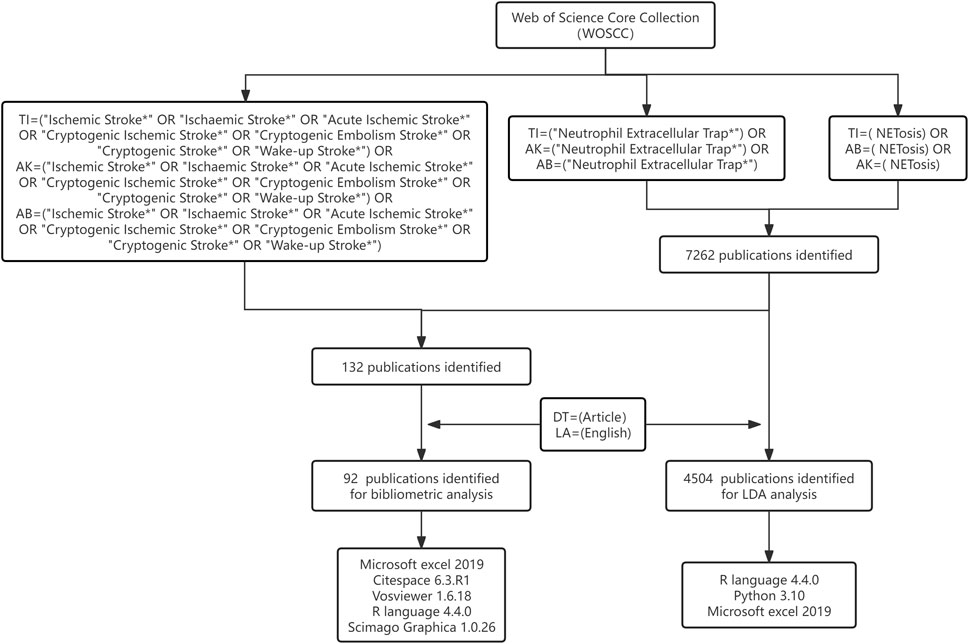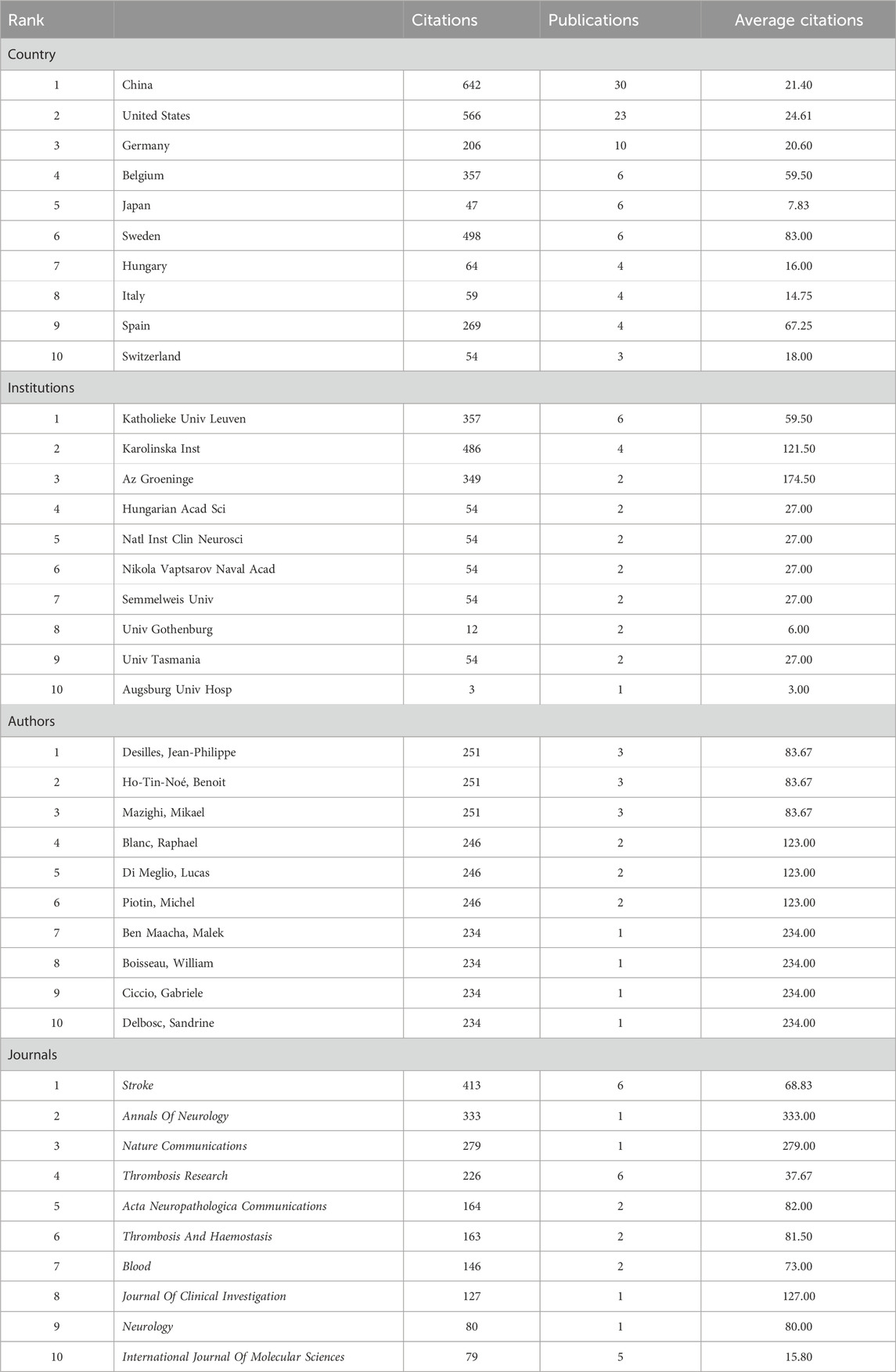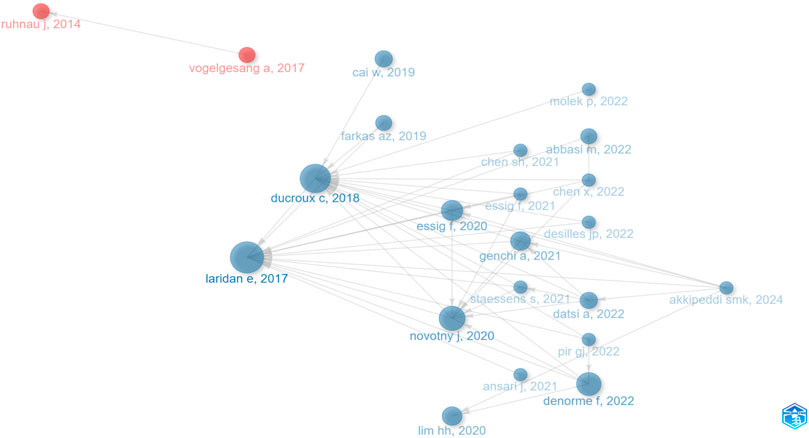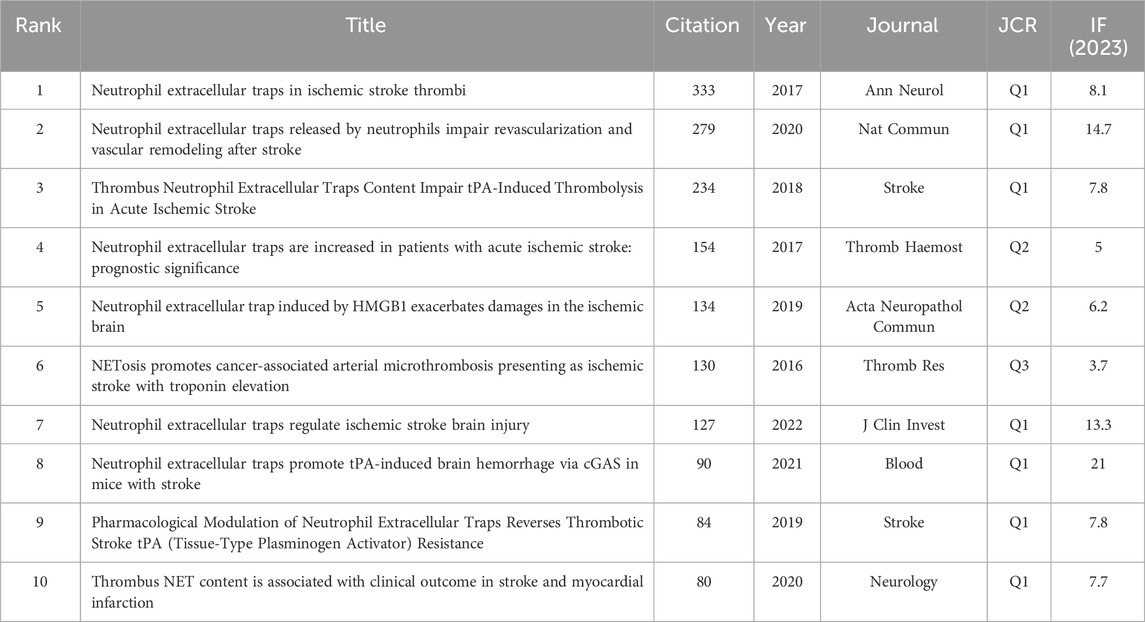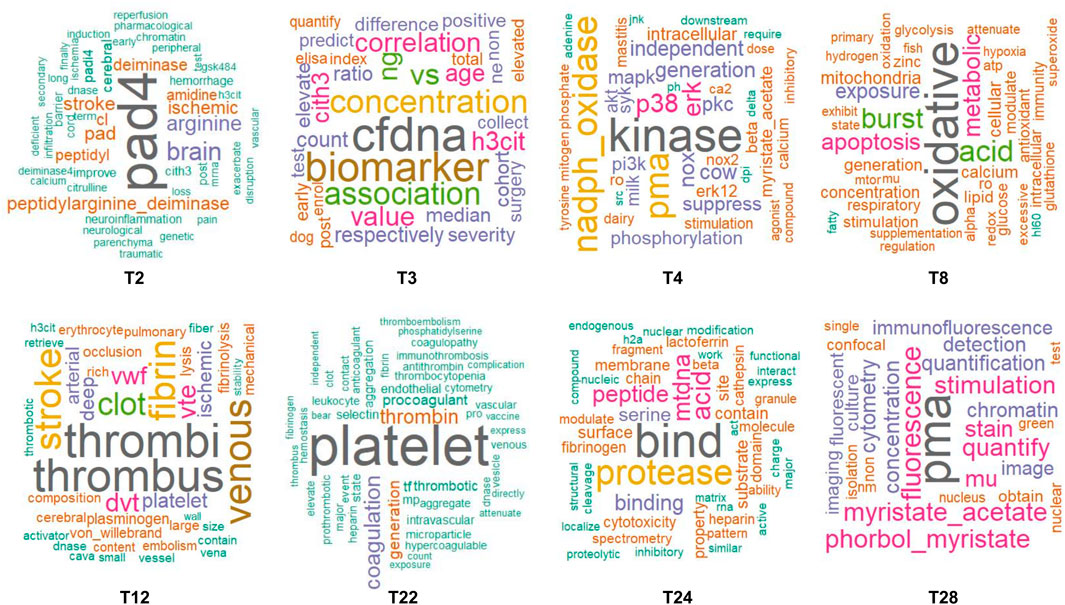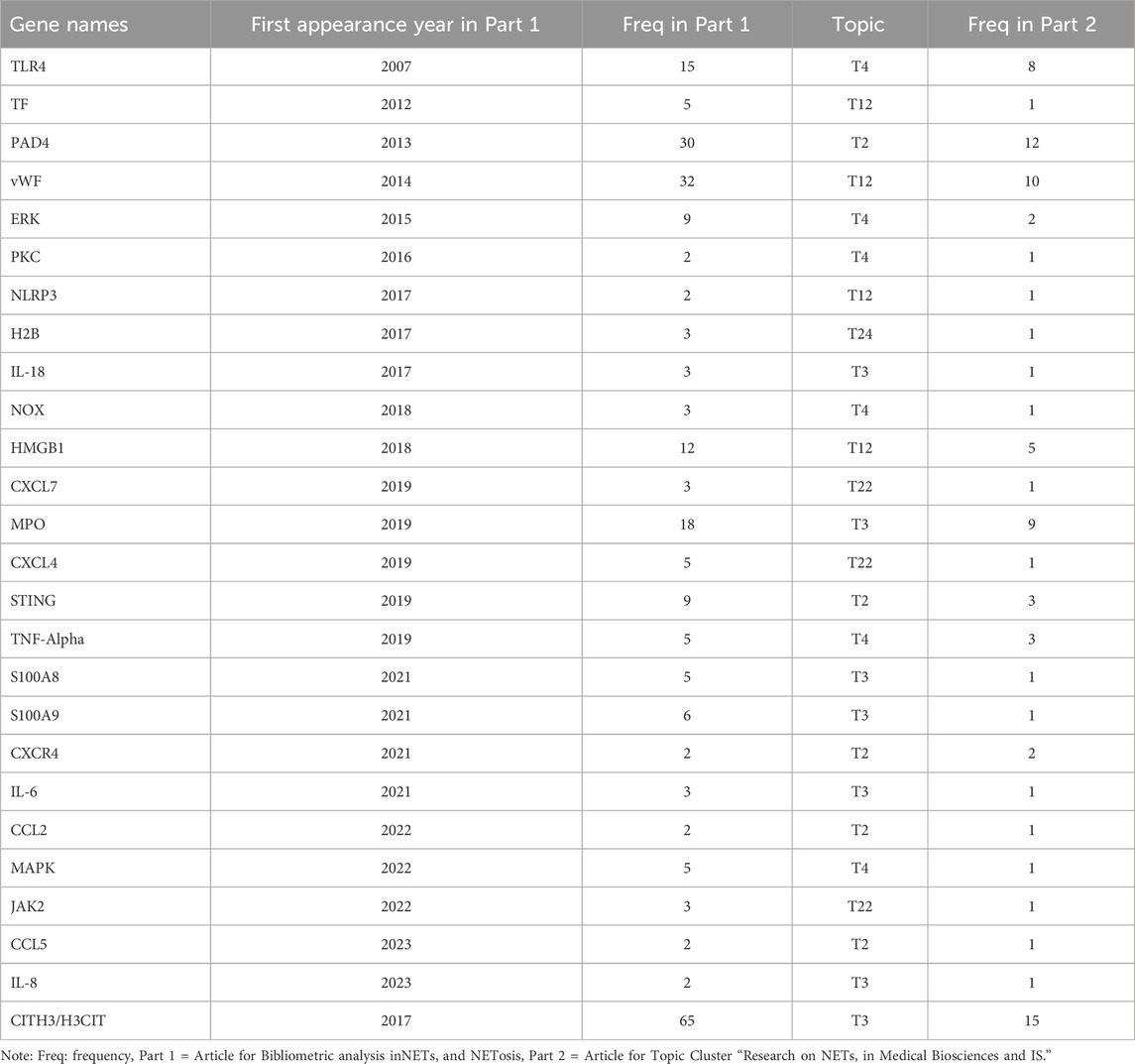- 1School of Preclinical Medicine, Chengdu University, Chengdu, China
- 2Development and Regeneration Key Laboratory of Sichuan Province, Chengdu Medical College, Chengdu, China
- 3School of Public Health, Chengdu University of Traditional Chinese Medicine, Chengdu, China
Background: Ischemic stroke (IS) remains a leading global cause of mortality and chronic disability. Neutrophil extracellular traps (NETs), recently identified as neutrophil-derived structures that trap and neutralize pathogens, have increasingly drawn attention for their involvement in IS pathogenesis. Despite a surge in related research, no bibliometric analyses have yet examined the knowledge framework and trends within this emerging field. Here, we conducted a systematic bibliometric analysis to map the research landscape and identify current and potential hotspots regarding NETs in IS.
Methods: Relevant literature published between 2014 and 2024 was systematically retrieved from the Web of Science Core Collection (WoSCC) database. Multiple analytical tools, including CiteSpace, VOSviewer, R package “bibliometrix,” and Python scripts, were employed to explore publication trends, academic collaborations, prominent research themes, and emerging topics.
Results: Ninety-two publications were eligible for bibliometric assessment, supplemented by an additional latent Dirichlet allocation (LDA)-based topic analysis of 4,504 documents. China (30 publications) and the United States (23 publications) emerged as leading countries in terms of research output, with global collaboration networks predominantly centering around the United States. Noteworthy contributions also arose from European institutions, particularly Katholieke Universiteit Leuven and Karolinska Institutet. The leading authors identified were Desilles, Jean-Philippe, Ho-Tin-Noé, Benoit, and Mazighi, Mikael. Journals such as Stroke, Annals of Neurology, and Nature Communications significantly influenced this domain. Three main research hotspots emerged: (1) “promoting effect of protein arginine deiminase 4 (PAD4) in NET formation,” (2) “cell-free DNA as a biomarker for disease diagnosis,” and (3) “influence of platelets and thrombosis on NETs-related diseases.”
Conclusion: Our study offers an extensive overview of existing literature and evolving research trajectories concerning NETs in IS, providing researchers with clear insights into current trends and future investigative directions. Nevertheless, our study has limitations—including dependence on a single database (WoSCC), restriction to English-language publications, and inherent constraints of the LDA methodology—that merit consideration in interpreting these findings.
1 Introduction
Ischemic stroke (IS), characterized by high morbidity, mortality, and severe long-term disabilities (Faustino et al., 2019; Hurford et al., 2020), remains a significant global health challenge, accounting for approximately 86.8% of all stroke cases (Koton et al., 2022; Tu et al., 2023). Pathologically, IS arises from the abrupt interruption of cerebral blood flow, typically due to thrombotic or embolic events, leading to acute neuronal injury and substantial neurological deficits (Tuo et al., 2022; Qin et al., 2022). Such neurological impairments markedly reduce patients’ quality of life. Current acute ischemic stroke (AIS) treatment relies on thrombolytic therapy and mechanical thrombectomy. These treatments have strict time limits: intravenous thrombolysis must be given within 4.5 h, and mechanical thrombectomy must be performed within 24 h. As a result, fewer than 10% of patients can benefit from these interventions (Wu et al., 2020; Hilkens et al., 2024). Consequently, there is an urgent need to identify novel therapeutic strategies.
Despite considerable advances in our understanding of IS, the underlying mechanisms remain incompletely elucidated. Pathophysiological processes involve complex interactions among oxidative stress, neuroinflammation, apoptosis, and necrosis, collectively exacerbating neuronal damage (Roth et al., 2018; Li et al., 2022b; Han et al., 2023; Gao et al., 2024). Recent research has indicated that neutrophil extracellular traps (NETs) may play a pivotal role in IS pathology (Kang et al., 2020; Denorme et al., 2022; Dhanesha et al., 2022), warranting comprehensive investigation as potential therapeutic targets.
Neutrophils are a fundamental component of the innate immune system, serving as primary defenders against infectious pathogens (Liew and Kubes, 2019). Brinkmann et al. first described NETs in 2004 as web-like structures composed of decondensed DNA intertwined with various granular proteins, released by activated neutrophils into the extracellular environment (Brinkmann et al., 2004; Fousert et al., 2020). NET formation primarily occurs via the NADPH oxidase-dependent reactive oxygen species (ROS) signaling pathway, highlighting neutrophils’ critical roles in infection management and inflammation regulation (Amulic et al., 2012).
In the context of IS, NETs exhibit dual and paradoxical roles (Manda-Handzlik and Demkow, 2019). Neutrophils can polarize into two distinct phenotypes: N1, a pro-inflammatory subtype that exacerbates neuronal injury, and N2, which exhibits protective properties (Hou et al., 2019; Cai et al., 2020). Under ischemic conditions, imbalances favoring the N1 phenotype increase NET formation, which may aggravate brain injury by intensifying thrombotic and inflammatory responses at lesion sites (Ducroux et al., 2018; Lim et al., 2020; Li et al., 2022a). Elevated NETs levels have been documented in the blood of AIS patients, suggesting their potential as early diagnostic markers, indicators of disease severity, and guides for therapeutic interventions (Vallés et al., 2017; Genchi et al., 2021). Nonetheless, current findings remain inconsistent, and a systematic bibliometric evaluation of the research landscape related to NETs in IS remains lacking.
Bibliometrics is a scientific metrology study employing statistical and computational methods to elucidate the structure, characteristics, and development of literature within specific research fields (Ellegaard and Wallin, 2015). By rapidly and precisely identifying critical research hotspots and future trajectories, bibliometrics has become an invaluable tool across numerous disciplines, including IS research (Wang et al., 2023a; Chen et al., 2023a; Zhu et al., 2023; Jiang et al., 2024). In this study, we employed bibliometric analysis to delineate research trends and highlight potential directions for investigations into NETs in IS over the past decade. Our goal is to clarify the evolution, current status, and future directions of this rapidly advancing field.
2 Methods
2.1 Data connection and search strategy
The Web of Science Core Collection (WoSCC) is a premier bibliometric database providing high-quality, structured data from over 13,000 reputable scholarly journals, making it highly suitable for bibliometric analyses (Singh et al., 2021; Yang et al., 2022). We conducted a comprehensive literature search in the WoSCC database on 12 August 2024, utilizing the following search terms: TI or AB or AK= (“Ischemic Stroke” OR “Ischaemic Stroke” OR “Acute lschemic Stroke” OR “Cryptogenic lschemic Stroke” OR “Cryptogenic Embolism Stroke” OR “Cryptogenic Stroke” OR “Wake-up Stroke”) and (“Neutrophil Extracellular Trap” or “NETosis”); TI or AB or AK = “Neutrophil Extracellular Trap” or “NETosis.” The search criteria were restricted to “Articles” published in English. The retrieved publications were exported in multiple formats, including plain text, Excel, BibTeX, and tab-delimited files. A detailed search strategy is provided in Supplementary Table 1. Ultimately, 92 and 4,504 records were chosen for further text analysis. The methodological framework employed in this study is illustrated in Figure 1.
2.2 Analysis and visualization
The software tools used for the literature dosage analysis were VOSviewer (version 1.6.20), CiteSpace (version 6.2.R2), Rstudio (version 4.4.0), and Python (version 3.10). VOSviewer facilitated the creation and visualization of co-authorship, co-occurrence, and co-citation networks acroos references, journals, and authors (van Eck and Waltman, 2010). CiteSpace, a specialized citation visualization software, was employed to forecast research trends by clustering keywords and visualizing journal dual-map overlays and keyword networks (Wu et al., 2021).
Additionally, latent Dirichlet allocation (LDA), a robust topic modeling approach widely applied across disciplines such as marketing, economics, and bioinformatics (Chen et al., 2022a), was utilized to identify prominent themes within large textual datasets. First, data preprocessing involved removing stop words. The optimal number of topics was determined by evaluating paired cosine distance (cao_juan_2009), Kullback-Leibler divergence (arun_2010), and the model coherence metric (coherence_mimno_2011) (Supplementary Figure 1). Following this evaluation, we selected 30 key topics based on consensus among the three methods. Topic labels were generated through independent labeling and classification methods, which focus on the top twenty weighted subject words and the top ten relevant articles. Two annotators independently label and classify the data. Cross-validation was subsequently conducted, and discrepancies were resolved through consultation with a third expert. Ultimately, this process led to the final set of topics and genes associated with NETs in IS. The 4,504 publications relating to NETs and NETosis were then imported into Python (version 3.10) for detailed LDA and gene analyses.
3 Results
3.1 Annual trends in publication
Research on ischemic stroke (IS), neutrophil extracellular traps (NETs), and NETosis has undergone significant development over the past decade. This bibliometric analysis systematically evaluated publication trends from 2014 to 2024 (Figure 2A). Results reveal a consistent increase in research output and scholarly attention. Initially modest from 2014 to 2018, publication volume steadily rose thereafter, peaking in 2021 and again in 2024, indicating renewed scientific interest. However, citation frequency fluctuated until 2022, followed by a rapid decline, suggesting a potential delay in recognizing the full impact of recent publications.
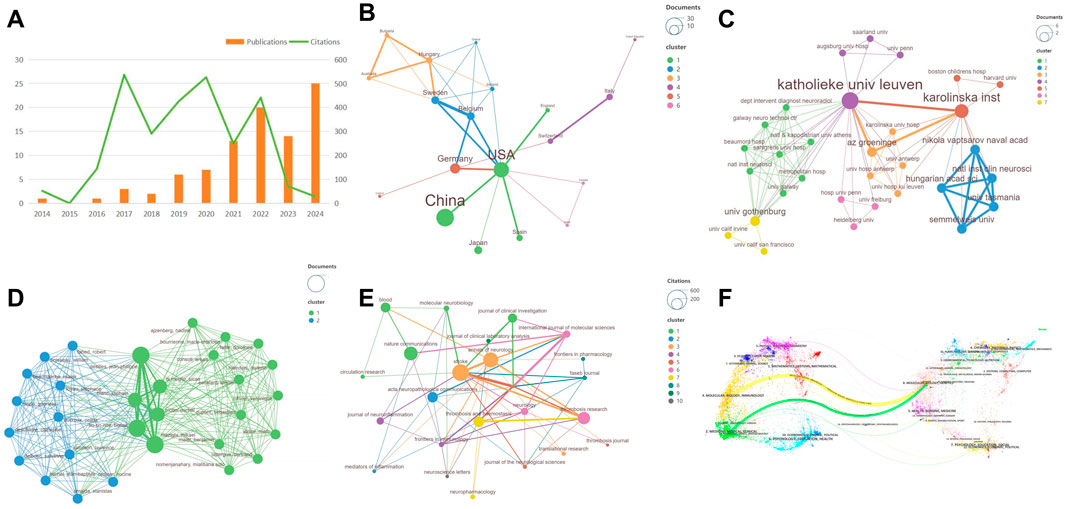
Figure 2. Annual publication trends and co-authorship network cluster analysis. (A) Publications and citations of IS-NETs over time; (B) Visualization of collaborative research efforts among countries; (C) Visualizations of co-authorship between institutions; (D) Visualization of author collaborations; (E) Visualization of journal co-citation networks with over 15 citations, with distinct clusters represented by different colors; (F) The dual-map overlap of journals.
3.2 Analysis of countries and institutions
China and the United States have led global research on NETs in IS, with China producing 30 publications and the United States 23 publications. Both countries dominate in total publication count and overall citations; However, their normalized citation impact remains relatively modest, suggesting quantity does not necessarily equate to influence. Notably, several European countries, such as Sweden and Spain, have demonstrated significant research impact despite fewer publications (Figure 2B; Table 1). The global collaboration network predominantly centers on the United States, particularly through strong partnerships with China and Germany.
European institutions significantly influence this research landscape. Katholieke Univ Leuven (six publications) and Karolinska Inst (four publications) are the leading institutions by publication output. However, Az Groeninge in Belgium exhibits the highest average citation rate, indicating its high research quality and influence. Additionally, our findings suggest that collaborative networks among these European institutions frequently align geographically (Figure 2C).
3.3 Analysis of authors and journals
A total of 716 authors have contributed significantly to NET-related IS research. The top three most productive authors—Jean-Philippe Desilles, Benoit Ho-Tin-Noé, and Mikael Mazighi—each contributed three publications with a cumulative citation count of 251. Although Malek Ben Maacha et al. achieved higher average citation rate of 234, the total number of publications by individual authors remains relatively limited (Table 1). Co-authorship analysis (Figure 2D) identifies a core collaborative network centered around Jean-Philippe Desilles and colleagues.
Fifty-nine distinct journals have published articles on NETs in IS, highlighting the interdisciplinary nature of the field. Journals such as Stroke, Annals of Neurology, and Nature Communications hold considerable influence, as indicated by citation analysis (Table 1). Co-citation network analysis positions Stroke as the most interconnected journal. This suggests that it may serve as a key bridge across various research areas (Figure 2E).
Figure 2F presents a dual-map overlay of journals generated by Citespace, depicting the primary citation pathways between citing and cited journals. Journals within medicine/clinical/healthcare and molecular/biology/immunology cite literature from molecular/biology/genetics journals. This illustrates the interdisciplinary cross-fertilization characterizing contemporary medical research and underscores foundational research’s broad impact.
3.4 Analysis of references and keywords
To better understand the evolution of research on NETs in IS, a historiographic timeline was constructed using R software to identify major shifts in focus and key milestones (Figure 3; Supplementary Table 2). The progression clearly outlines initial explorations into pathological mechanisms transitioning toward therapeutic applications.
Between 2014 and 2017, research focused on neutrophil and monocyte function post-IS. Subsequent studies (2017–2019) examined NETs’ roles in stroke-related thrombosis. From 2019 to 2022, the scope broadened to include NETs as diagnostic biomarkers, their involvement across various clot types, and associations with clinical outcomes. Recent studies (2023–2024) have further specialized, investigating COVID-19 impacts on clot composition and exploring connections between NETs and collateral circulation, advancing the understanding of IS pathology and potential treatments.
Table 2 summarizes the top 10 most-cited publications. It reveals a shift from foundational mechanistic insights toward clinical relevance. Initially (2016–2017), studies validated NET presence and fundamental roles in IS. Later publications increasingly targeted clinical implications, assessing NETs in prognosis (2017) and therapeutic responsiveness (2018). Furthermore, research expanded from thrombotic involvement (2017) to broader implications in vascular remodeling (2020), cerebral injury (2019, 2022), and related areas. Collectively, these influential studies emphasize NETs’ increasing importance in IS, moving progressively from basic biology to practical clinical strategies.
Keyword analysis via VOSviewer (Figure 4A) and CiteSpace (Figure 4B) revealed research focal points. Recently emphasized keywords include “thrombectomy,” “thromboinflammation,” and “blood-brain barrier.” Additionally, emerging research themes such as “bioinformatics analysis,” “von Willebrand factor,” and “thrombectomy” reflect the field’s evolving and increasingly specialized landscape.
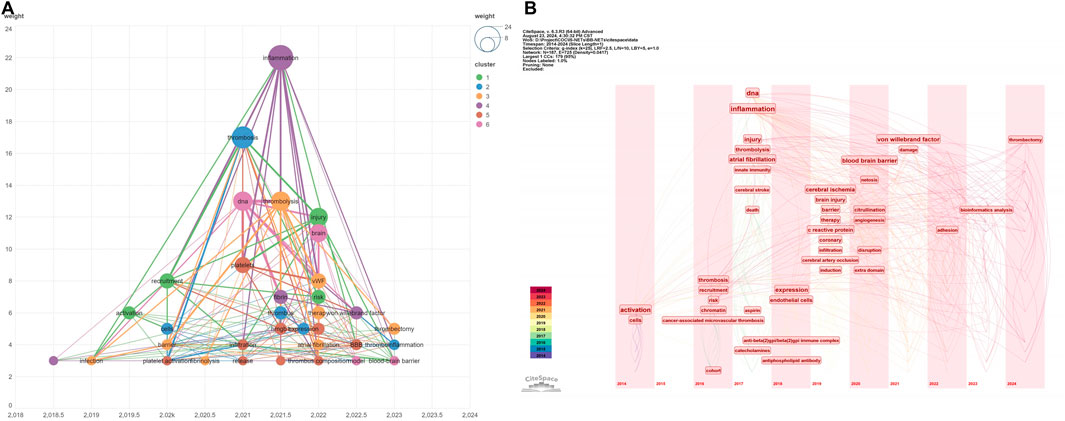
Figure 4. Keyword analysis visualizations in IS-NETs research. (A) Temporal overlay visualization of keyword co-occurrence; (B) Keyword timeline visualization.
3.5 Topic modeling
Due to the limited volume of existing research specifically addressing NETs in IS, we employed LDA topic modeling to analyze 4,504 publications related broadly to NETs and NETosis to explore new research directions. Following established analytical criteria, 30 key topics were identified (Supplementary Figure 2), which were subsequently named based on their primary terms and related articles (Supplementary Tables 3, 4). These topics were categorized into two broad themes: the role of NETs in disease, and biomedical research on NETs related specifically to IS (Table 3). We visualized eight relevant biomedical topics associated with NETs in IS through word cloud analyses (Figure 5). These central themes included “pad4,” “cfdna,” “kinase,” “oxidative,” “thrombi,” “platelet,” “bind,” and “pma.” For example, topic 2 prominently featured “pad4,” reflecting its central role in NET formation in IS, accompanied by secondary terms such as “neuroinflammation”, “barrier”, and “hemorrhage.” These terms collectively highlight research on NETs’ influence on neuroinflammation, blood-brain barrier integrity, hemorrhagic complications, and potential pharmacological interventions targeting NET formation. Topic 3 emphasized cell-free DNA (cfDNA) as a potential biomarker for disease diagnosis and prognosis, with frequent terms including “biomarker,” “concentration”, and “association,” underscoring the diagnostic potential of cfDNA. Terms such as “nucleosome,” “H3Cit,” and “CitH3” indicated a specific focus on DNA markers linked to NETs.
Topic 4 concentrated on signaling pathways underlying NET formation, evidenced by high-frequency terms such as “kinase,” “NADPH oxidase,” “ERK,” and “p38,” which reflect the involvement of kinases and oxidoreductases. This topic highlights research on signaling pathways, including MAPK, PI3K/AKT, and PKC, in regulating NET production. Topic 8 centered around oxidative stress and autophagy. Common terms like “oxidative,” “stress,” “autophagy,” and “mitochondrial” underscore the significance of oxidative stress and mitochondrial function in generating NETs. Topic 12 addresses thrombosis and the role of fibrin networks in NETs-associated diseases. Dominant terms like “thrombi,” “thrombus,” “venous,” and “fibrin” emphasize thrombus formation, particularly in venous thrombosis and fibrin networks. The terms “stroke” and “ischemic” indicate that the studies also investigate the role of NETs in IS.
3.6 Gene analysis
We analyzed and extracted relevant genetic elements from the eight identified themes, resulting in 312 associated genes (Supplementary Table 5). By comparing genes occurring more than twice within our dataset to those documented in 92 IS-NETs-related publications, we identified 26 overlapping genes (Table 4). These shared genes highlight several research topics, such as “NETs in medical and biological sciences,” which remain underexplored within IS-specific NETs literature, despite their potential significance. This finding highlights critical opportunities for innovation and points toward future research directions. Furthermore, our LDA topic modeling identified several areas corresponding with current research hotspots, reinforcing their significance in IS research.
The identified genes are pivotal in multiple biological pathways and mechanisms associated with NET formation and function, including inflammation, coagulation, oxidative stress, and cell signaling. Key genes like CITH3/H3CIT, PAD4, and MPO are directly involved in NET formation, making them essential to NETs research. Coagulation-related genes such as von Willebrand factor (vWF) and Tissue Factor are crucial for NETs-associated thrombosis. Mediators like TLR4 and HMGB1 initiate NET formation and subsequent inflammatory responses. Inflammatory regulators, including S100A8/A9, TNF-α, IL-6, and IL-8, modulate inflammation related to NET activity. Signaling pathway-associated genes like ERK, STING, MAPK, and JAK2 potentially govern NET formation via various cell signaling cascades. Additionally, chemokines CXCL4 and CXCL7 participate in immune cell recruitment processes connected to NETs, while NLRP3 is associated with NET-induced inflammasome activation.
4 Discussion
This study presents a comprehensive bibliometric analysis of research on neutrophil extracellular traps (NETs) in ischemic stroke (IS), covering publications from 1 January 2014, to 12 August 2024. This is, to our knowledge, the first systematic bibliometric evaluation of NETs-related research within the context of IS. We employed qualitative, quantitative, and integrative approaches to identify current research trends, hotspots, and potential future directions in this field.
4.1 General information
Our bibliometric analysis reveals a steady annual growth in research publications on NETs in IS, despite the relatively limited total publication volume. Although there was a slight decrease in 2023, a surge is projected for 2024, highlighting the substantial research potential and increasing interest in this area. However, recent declines in citation frequency (Figure 2A) post 2022 suggest that factors such as publication lag, research funding fluctuations, and shifting scientific priorities may be influencing the perceived impact of this body of work. Additionally, improving research quality remains needed to enhancing the scholarly impact of future publications.
China and the United States dominate this research domain, likely due to their extensive research initiatives and strong financial support systems. Nevertheless, normalized citation metrics for China are comparatively lower, possibly reflecting weaker international collaboration networks, limited cross-institutional referencing, or publication in journals with moderate impact; only two of the ten most cited publications since 2020 have originated from Chinese researchers. European institutions, particularly Katholieke Universiteit Leuven and Karolinska Institutet, have substantial publication outputs driven by geographical proximity facilitating collaboration (Figure 2C). Conversely, limited cooperation between Asian and European institutions presents a barrier to international research collaboration and academic advancement. To overcome these challenges, enhancing international research collaboration through strategic funding initiatives and institutional partnerships is essential.
Journal analysis indicates that Stroke, Annals of Neurology, and Nature Communications lead in contributions in this field, all ranked within the Q1 category according to Journal Citation Reports (JCR) (Table 2). Among the top ten cited journals, three journals possess an impact factor (IF) over 10, and nine have IF values greater than 5, highlighting the high quality of research published. Prominent neuroscience journals, including Stroke, Annals of Neurology, and Acta Neuropathologica Communications, have significantly advanced understanding of NETs in IS, reinforcing NETs’ importance as biomarkers and potential therapeutic targets (Laridan et al., 2017; Ducroux et al., 2018; Kang et al., 2020).
The most cited publication, authored by Laridan et al. from KU Leuven Campus Kulak Kortrijk, titled “Neutrophil Extracellular Traps in Ischemic Stroke Thrombi” appeared in Annals of Neurology 7 years ago (Laridan et al., 2017). This foundational study demonstrated H3Cit, a NET-specific marker, in nearly all analyzed thrombi from IS patients, correlating NETs with cardiac etiology and specific histopathological features. These insights have significantly advanced our understanding of IS pathophysiology and therapeutic opportunities targeting NETs. The second most influential study by Kang et al., published in Nature Communications in 2020, elucidated how NETs impede vascular remodeling following IS (Kang et al., 2020). This study showed that the increased expression of the enzyme PAD4 exacerbated blood-brain barrier disruption and impaired neurovascular repair, ultimately worsening patient outcomes. The third most referenced article, published 6 years ago in Stroke by Celina Ducroux et al. from the Université Paris Diderot, is titled “Thrombus Neutrophil Extracellular Traps Content Impair tPA-Induced Thrombolysis in Acute Ischemic Stroke” (Ducroux et al., 2018). It suggested that NETs within thrombi may contribute to thrombolytic resistance in IS, hindering successful reperfusion despite mechanical thrombectomy or pharmacological thrombolysis treatments. Importantly, this study highlighted recombinant DNase1 as a promising therapeutic adjunct to accelerate tissue plasminogen activator (t-PA)-mediated thrombolysis. Collectively, these three articles emphasized the therapeutic potential of targeting NETs in IS and highlight the importance of further research exploring NET-driven pathological mechanisms to enhance clinical outcomes.
4.2 The hotspots and the frontiers
Keywords and word cloud analyses could offer valuable insights into emerging trends within NET-related ischemic stroke (IS) research, though the literature remains relatively sparse. To address this gap, we applied latent Dirichlet allocation (LDA) topic modeling to a comprehensive dataset of 4,504 NET and NETosis-related publications. We identified eight distinct themes, represented through targeted word clouds, highlighting critical areas of current and potential future research (Figure 5). Topic 2 focuses on the essential role of PAD4 in NET formation and its implications for IS. As a key enzyme in the NETosis process, PAD4 expression and activity significantly increase following IS (Kim, et al., 2020), exacerbating blood-brain barrier disruption and hindering neurovascular regeneration, thus impairing post-stroke recovery (Kang et al., 2020). PAD4 overexpression also induces neuroinflammation and neuronal death via the STING-dependent IRE1α/ASK1/JNK signaling pathway, as demonstrated in traumatic brain injury models (Shi et al., 2023). PAD4 inhibition has yielded promising anti-inflammatory results in various conditions like asthma, spinal cord injury, and inflammatory bowel disease (IBD) (Feng et al., 2021; Chen et al., 2023c; Wang et al., 2024). Recent advancements in PAD4 inhibitors, especially in cancer research, present promising avenues for therapeutic applications in IS management (Deng et al., 2022).
Topic 3 emphasizes circulating cell-free DNA (cfDNA) as a diagnostic and prognostic biomarker. Elevated cfDNA originates from cellular apoptosis, necrosis, and secretion during pathological states, including inflammation, infection, and cancer (Chen et al., 2022b; Wang et al., 2022). It has been reported that 7-day cfDNA concentration is associated with clinical outcomes, particularly mortality rates in IS by cohort studies (Grosse et al., 2022). Additionally, cfDNA assists in evaluating short-term outcomes in AIS and the risk of hemorrhage post-thrombolysis (Orbán-Kálmándi et al., 2021b). NETs are associated with poor prognoses in patients with IS and may contribute to inflammation and thrombosis (Baumann et al., 2024). Therefore, integrating cfDNA with NET biomarkers may enhance our understanding of IS pathophysiology. Future applications of bioinformatics and machine learning may further optimize cfDNA and NETs biomarker usage for improved diagnostic accuracy and treatment monitoring (Wang et al., 2023b).
Topics 12 and 22 examine platelets’ roles and thrombotic mechanisms in NET-related diseases. Historically, thrombi predominantly comprise platelets, fibrin, and erythrocytes; however, increasing evidence highlights neutrophils’ contributions. Studies by Elodie et al. have documented NETs in thrombi and the presence of neutrophils in these clots, even if their numbers vary among IS patients (Laridan et al., 2017). Platelets are essential for clotting as they release cytokines and bioactive substances like CXCL4, which triggers NETosis—a critical process where neutrophils expel their DNA to ensnare pathogens and debris (Matsumoto et al., 2021; Jarrahi et al., 2023). In platelet-rich regions of IS clots, the composition becomes complex, including fibrin, von Willebrand factor (vWF), and DNA (Wang et al., 2018). Research shows von Willebrand factor (vWF) deficiency significantly reduces NET formation in IS models, identifying vWF as a potential therapeutic target (De Wilde et al., 2022).
Additionally, biomarkers reflective of NET levels, such as MPO, citH3, cfDNA, nucleosomes, and DNase-I, have predictive value in peripheral artery and coronary artery ischemic diseases (Bang et al., 2019; Orbán-Kálmándi et al., 2021a). In AIS patients, peripheral blood NETs and neutrophil counts significantly elevate within 24 h post-stroke, correlating with increased severity and poorer prognosis, further emphasizing NETs’ roles in ischemic pathophysiology and their potential for disease monitoring (Datsi et al., 2022; Huang et al., 2022; Liaptsi et al., 2023). Although data during the hyperacute phase of stroke are limited, animal models show dynamic NET changes, detectable at 6 h, peaking at 24 h, and decreasing at 48 h post-stroke (De Wilde et al., 2022). These observations demonstrate the utility of word cloud analyses for rapidly identifying emerging research trends on NETs in IS.
Importantly, several highly expressed genes significantly influence NET formation and function in IS. Elevated HMGB1 levels during the acute stroke phase correlate with worse outcomes by enhancing NET formation and recruitment, leading to neurofunctional deficits (Shan et al., 2022; Mu et al., 2024b). During acute inflammation, NET-microparticle complexes facilitated neutrophil recruitment through the HMGB1-TLR2/TLR4 signaling pathway (Wang et al., 2019). Furthermore, NETs intensify inflammatory responses via TLR4/HIF-1α signaling in choroidal endothelial cells (Zeng et al., 2023). The MPO-DNA, an accurate marker of NET formation, peaks around 24 h post-stroke, representing an optimal therapeutic window (Li et al., 2024).
Several important markers are closely tied to post-stroke inflammation. Notably, NODlike receptor family pyrin domain-containing 3 (NLRP3), the most extensively studied inflammasome component, can be activated by TLR ligands (Guo et al., 2015). There is emerging evidence that the activation of NLRP3 inflammasome is involved in NETosis. This activation may also contribute to the onset of thrombosis (Broz and Dixit, 2016). PAD4, vital for NETosis initiation, also participates in NLRP3 inflammasome activation, and NLRP3 gene ablation significantly decreases NET release (Münzer et al., 2021). NETs trigger caspase-1 activation within macrophages, further enhancing NLRP3 inflammasome activity (Kahlenberg et al., 2013). Research demonstrates that the NLRP3 inflammasome is essential for the release of NETs (Kumar et al., 2023), and consequently, dual-target inhibitors of NLRP3 and PAD4 offer promising clinical potential.
There is a complex relationship between NETs and oxidative stress, which leads to neuronal dysfunction and death through excessive ROS and reactive nitrogen species (RNS) production (Manoj et al., 2025). Excess ROS/RNS activation triggers mast cells and macrophages to release inflammatory cytokines such as TNF, IL-10, and IL-1 (Hotchkiss and Karl, 2003), which are critical for neutrophil adhesion and migration. Intracellular ROS mediates NETosis signaling, subsequently released NETs further amplify inflammatory cytokine production, creating a feedback loop that accelerates disease progression (Stoiber et al., 2015). Chen et al. suggested that regulating the Nrf2 signaling pathway can reduce mitochondrial oxidative damage, thereby providing neuroprotective effects (Chen et al., 2023b). Acknowledging the importance of interconnected mechanisms—like neutrophil extracellular traps, oxidative stress, and mitochondrial disfunction—can assist in identifying effective biomarkers and therapeutic targets for treating stroke.
Recent studies have shown that PAD4 inhibitor like BB-Cl-amidine (BBCA) could significantly reduce infarct volume and improve neurological function in MCAO rats. BBCA blocked the accumulation of citrullinated proteins (F95) during the acute phase and suppressed NETosis induction in the subacute phase (Seol et al., 2025). Similarly, the selective PAD4 inhibitor GSK484 reduced PAD4 activity by decreasing H3Cit+ EET production, suggesting its potential as an antithrombotic therapeutic agent (Martinod et al., 2024). To enhance drug delivery to ischemic regions, Mu, Q. et al. synthesized a neutrophil-targeting delivery system that responds to ROS and is loaded with GSK484. This innovative system could significantly boost the accumulation of GSK484 nanoparticles in brain lesions, reduce NET formation, and inhibit neuroinflammation (Mu et al., 2024a). Thus, PAD4 blockade forms a critical foundation for multi-mechanism targeted drug development. Still, clinical trials remain essential for validating these preclinical findings (Jiang et al., 2024). Despite the extensive research on IS, few clinical drug trials specifically target NETs. Notably, Fondation Ophtalmologique Adolphe de Rothschild initiated a phase 2 clinical trial (NCT04785066) evaluating the efficacy of NET-targeting Dornase alfa (Pulmozyme®) in IS, indicating significant progress toward clinical application.
4.3 Strengths and limitations
This study represents the first systematic bibliometric analysis to investigate research trends and developments concerning NETs in ischemic stroke (IS). By employing diverse bibliometric methods, our approach reduces analytical biases typically associated with conventional reviews. Furthermore, our findings reveal more distinct regional differences in research focus and output, highlighting the most influential authors, journals, and institutions. This information serves as a valuable reference for emerging researchers. Moreover, the LDA topic model identifies and visually represents eight core research topics related to NETs in biomedical and IS contexts, which helps future validation and exploration. Finally, the analysis of high-frequency genes, including PAD4, VWF, MPO, TLR4, and HMGB1, is closely related to NET formation, NLRP3 inflammasome activation, and oxidative stress pathways, thus identifying potential biomarkers and therapeutic targets.
Inevitably, this study has several limitations. Firstly, our analysis only included original English-language articles from the Web of Science Core Collection database, possibly limiting the comprehensiveness of our findings. Second, the relatively modest sample size of ninety-two publications may affect the robustness of our network analyses. Third, inherent methodological constraints of the LDA model—which segments sentences into individual words based solely on frequency—might not fully preserve the original context and nuanced significance of specific terms or phrases.
5 Conclusion
Our bibliometric analysis demonstrates a steadily growing interest in research exploring the interplay between NETs and IS. China and the United States are the leading nations significantly advancing research in this field. Three of the most cited papers discuss NETs and their contributions to thrombus formation, interference with thrombolytic therapies, and exacerbation of neurovascular injuries post-IS. Future research should focus on PAD4-mediated regulation of NET formation and the complex relationship between NETs and thrombosis, considering their dualistic nature in ischemic stroke pathology. Such research promises novel therapeutic strategies prioritizing neuroprotective outcomes. Targeting NETs thus emerges as a crucial area for future IS research, potentially improving patient prognosis and clinical management.
Data availability statement
The original contributions presented in the study are included in the article/Supplementary Material, further inquiries can be directed to the corresponding author.
Author contributions
YX: Conceptualization, Writing – original draft, Writing – review and editing, Data curation, Funding acquisition. XG: Methodology, Software, Visualization, Writing – original draft. YW: Methodology, Software, Visualization, Writing – original draft. XL: Methodology, Software, Visualization, Writing – original draft. HP: Writing – review and editing. HJ: Methodology, Software, Visualization, Writing – original draft. XY: Writing – review and editing, Funding acquisition.
Funding
The author(s) declare that financial support was received for the research and/or publication of this article. This work was funded by the National Natural Science Foundation of China (Grant No. 82073539) and the Open Fund of Development and Regeneration Key Laboratory of Sichuan Province (Grant No. 24FYYZS09).
Conflict of interest
The authors declare that the research was conducted in the absence of any commercial or financial relationships that could be construed as a potential conflict of interest.
Generative AI statement
The author(s) declare that no Generative AI was used in the creation of this manuscript.
Publisher’s note
All claims expressed in this article are solely those of the authors and do not necessarily represent those of their affiliated organizations, or those of the publisher, the editors and the reviewers. Any product that may be evaluated in this article, or claim that may be made by its manufacturer, is not guaranteed or endorsed by the publisher.
Supplementary material
The Supplementary Material for this article can be found online at: https://www.frontiersin.org/articles/10.3389/fphar.2025.1537566/full#supplementary-material
References
Amulic, B., Cazalet, C., Hayes, G. L., Metzler, K. D., and Zychlinsky, A. (2012). Neutrophil function: from mechanisms to disease. Annu. Rev. Immunol. 30, 459–489. doi:10.1146/annurev-immunol-020711-074942
Bang, O. Y., Chung, J. W., Cho, Y. H., Oh, M. J., Seo, W. K., Kim, G. M., et al. (2019). Circulating DNAs, a marker of neutrophil extracellular traposis and cancer-related stroke: the OASIS-cancer study. Stroke 50 (10), 2944–2947. doi:10.1161/STROKEAHA.119.026373
Baumann, T., de Buhr, N., Blume, N., Gabriel, M. M., Ernst, J., Fingerhut, L., et al. (2024). Assessment of associations between neutrophil extracellular trap biomarkers in blood and thrombi in acute ischemic stroke patients. J. Thromb. Thrombolysis 57 (6), 936–946. doi:10.1007/s11239-024-03004-y
Brinkmann, V., Reichard, U., Goosmann, C., Fauler, B., Uhlemann, Y., Weiss, D. S., et al. (2004). Neutrophil extracellular traps kill bacteria. Science 303 (5663), 1532–1535. doi:10.1126/science.1092385
Broz, P., and Dixit, V. M. (2016). Inflammasomes: mechanism of assembly, regulation and signalling. Nat. Rev. Immunol. 16 (7), 407–420. doi:10.1038/nri.2016.58
Cai, W., Liu, S., Hu, M., Huang, F., Zhu, Q., Qiu, W., et al. (2020). Functional dynamics of neutrophils after ischemic stroke. Trans. Stroke Res. 11 (1), 108–121. doi:10.1007/s12975-019-00694-y
Chen, J., Chen, G., Xu, X., Chen, L., Zhang, J., and Liu, F. (2023a). Bibliometric analysis and visualized study of research on autophagy in ischemic stroke. Front. Pharmacol. 14, 1232114. doi:10.3389/fphar.2023.1232114
Chen, J., Williams, M., Huang, Y., and Si, S. (2022a). Identifying topics and evolutionary trends of literature on brain metastases using latent dirichlet allocation. Front. Mol. Biosci. 9, 858577. doi:10.3389/fmolb.2022.858577
Chen, L., Chen, S., Yang, X. F., and Min, J. W. (2023b). Antioxidants attenuate mitochondrial oxidative damage through the Nrf2 pathway: a promising therapeutic strategy for stroke. J. Neurosci. Res. 101 (8), 1275–1288. doi:10.1002/jnr.25194
Chen, Y., Gong, Y., Dou, L., Zhou, X., and Zhang, Y. (2022b). Bioinformatics analysis methods for cell-free DNA. Comput. Biol. Med. 143, 105283. doi:10.1016/j.compbiomed.2022.105283
Chen, Y. R., Xiang, X. D., Sun, F., Xiao, B. W., Yan, M. Y., Peng, B., et al. (2023c). Simvastatin reduces NETosis to attenuate severe asthma by inhibiting PAD4 expression. Oxid. Med. Cell Longev. 2023, 1493684. doi:10.1155/2023/1493684
Datsi, A., Piotrowski, L., Markou, M., Köster, T., Kohtz, I., Lang, K., et al. (2022). Stroke-derived neutrophils demonstrate higher formation potential and impaired resolution of CD66b + driven neutrophil extracellular traps. BMC Neurol. 22 (1), 186. doi:10.1186/s12883-022-02707-0
Deng, H., Lin, C., Garcia-Gerique, L., Fu, S., Cruz, Z., Bonner, E. E., et al. (2022). A novel selective inhibitor JBI-589 targets PAD4-mediated neutrophil migration to suppress tumor progression. Cancer Res. 82 (19), 3561–3572. doi:10.1158/0008-5472.CAN-21-4045
Denorme, F., Portier, I., Rustad, J. L., Cody, M. J., de Araujo, C. V., Hoki, C., et al. (2022). Neutrophil extracellular traps regulate ischemic stroke brain injury. J. Clin. Invest. 132 (10), e154225. doi:10.1172/JCI154225
De Wilde, M., Desender, L., Tersteeg, C., Vanhoorelbeke, K., and De Meyer, S. F. (2022). Spatiotemporal profile of neutrophil extracellular trap formation in a mouse model of ischemic stroke. Res. Pract. Thromb. Haemost. 7 (1), 100028. doi:10.1016/j.rpth.2022.100028
Dhanesha, N., Patel, R. B., Doddapattar, P., Ghatge, M., Flora, G. D., Jain, M., et al. (2022). PKM2 promotes neutrophil activation and cerebral thromboinflammation: therapeutic implications for ischemic stroke. Blood 139 (8), 1234–1245. doi:10.1182/blood.2021012322
Ducroux, C., Di Meglio, L., Loyau, S., Delbosc, S., Boisseau, W., Deschildre, C., et al. (2018). Thrombus neutrophil extracellular traps content impair tPA-induced thrombolysis in acute ischemic stroke. Stroke 49 (3), 754–757. doi:10.1161/STROKEAHA.117.019896
Ellegaard, O., and Wallin, J. A. (2015). The bibliometric analysis of scholarly production: how great is the impact? Scientometrics 105 (3), 1809–1831. doi:10.1007/s11192-015-1645-z
Faustino, J., Chip, S., Derugin, N., Jullienne, A., Hamer, M., Haddad, E., et al. (2019). CX3CR1-CCR2-dependent monocyte-microglial signaling modulates neurovascular leakage and acute injury in a mouse model of childhood stroke. J. Cereb. Blood Flow. Metab. 39 (10), 1919–1935. doi:10.1177/0271678X18817663
Feng, Z., Min, L., Liang, L., Chen, B., Chen, H., Zhou, Y., et al. (2021). Neutrophil extracellular traps exacerbate secondary injury via promoting neuroinflammation and blood-spinal cord barrier disruption in spinal cord injury. Front. Immunol. 12, 698249. doi:10.3389/fimmu.2021.698249
Fousert, E., Toes, R., and Desai, J. (2020). Neutrophil extracellular traps (NETs) take the central stage in driving autoimmune responses. Cells 9 (4), 915. doi:10.3390/cells9040915
Gao, M., Li, Y., Ho, W., Chen, C., Chen, Q., Li, F., et al. (2024). Targeted mRNA nanoparticles ameliorate blood-brain barrier disruption postischemic stroke by modulating microglia polarization. ACS Nano 18 (4), 3260–3275. doi:10.1021/acsnano.3c09817
Genchi, A., Semerano, A., Gullotta, G. S., Strambo, D., Schwarz, G., Bergamaschi, A., et al. (2021). Cerebral thrombi of cardioembolic etiology have an increased content of neutrophil extracellular traps. J. Neurol. Sci. 423, 117355. doi:10.1016/j.jns.2021.117355
Grosse, G. M., Blume, N., Abu-Fares, O., Götz, F., Ernst, J., Leotescu, A., et al. (2022). Endogenous deoxyribonuclease activity and cell-free deoxyribonucleic acid in acute ischemic stroke: a cohort study. Stroke 53 (4), 1235–1244. doi:10.1161/STROKEAHA.121.036299
Guo, H., Callaway, J. B., and Ting, J. P. (2015). Inflammasomes: mechanism of action, role in disease, and therapeutics. Nat. Med. 21 (7), 677–687. doi:10.1038/nm.3893
Han, W., Pu, H., Li, S., Liu, Y., Zhao, Y., Xu, M., et al. (2023). Targeted ablation of signal transducer and activator of transduction 1 alleviates inflammation by microglia/macrophages and promotes long-term recovery after ischemic stroke. J. Neuroinflammation 20 (1), 178. doi:10.1186/s12974-023-02860-4
Hilkens, N. A., Casolla, B., Leung, T. W., and de Leeuw, F. E. (2024). Stroke. Lancet 403 (10446), 2820–2836. doi:10.1016/S0140-6736(24)00642-1
Hotchkiss, R. S., and Karl, I. E. (2003). The pathophysiology and treatment of sepsis. N. Engl. J. Med. 348 (2), 138–150. doi:10.1056/NEJMra021333
Hou, Y., Yang, D., Xiang, R., Wang, H., Wang, X., Zhang, H., et al. (2019). N2 neutrophils may participate in spontaneous recovery after transient cerebral ischemia by inhibiting ischemic neuron injury in rats. Int. Immunopharmacol. 77, 105970. doi:10.1016/j.intimp.2019.105970
Huang, Y., Zhang, X., Zhang, C., Xu, W., Li, W., Feng, Z., et al. (2022). Edaravone dexborneol downregulates neutrophil extracellular trap expression and ameliorates blood-brain barrier permeability in acute ischemic stroke. Mediat. Inflamm. 2022, 3855698. doi:10.1155/2022/3855698
Hurford, R., Wolters, F. J., Li, L., Lau, K. K., Küker, W., Rothwell, P. M., et al. (2020). Prevalence, predictors, and prognosis of symptomatic intracranial stenosis in patients with transient ischaemic attack or minor stroke: a population-based cohort study. Lancet Neurol. 19 (5), 413–421. doi:10.1016/S1474-4422(20)30079-X
Jarrahi, A., Khodadadi, H., Moore, N. S., Lu, Y., Awad, M. E., Salles, E. L., et al. (2023). Recombinant human DNase-I improves acute respiratory distress syndrome via neutrophil extracellular trap degradation. J. Thromb. Haemost. 21 (9), 2473–2484. doi:10.1016/j.jtha.2023.04.044
Jiang, N., Yang, T., Han, H., Shui, J., Hou, M., Wei, W., et al. (2024). Exploring research trend and hotspots on oxidative stress in ischemic stroke (2001-2022): insights from bibliometric. Mol. Neurobiol. 61 (9), 6200–6216. doi:10.1007/s12035-023-03909-4
Kahlenberg, J. M., Carmona-Rivera, C., Smith, C. K., and Kaplan, M. J. (2013). Neutrophil extracellular trap-associated protein activation of the NLRP3 inflammasome is enhanced in lupus macrophages. J. Immunol. 190 (3), 1217–1226. doi:10.4049/jimmunol.1202388
Kang, L., Yu, H., Yang, X., Zhu, Y., Bai, X., Wang, R., et al. (2020). Neutrophil extracellular traps released by neutrophils impair revascularization and vascular remodeling after stroke. Nat. Commun. 11 (1), 2488. doi:10.1038/s41467-020-16191-y
Kim, S. W., Davaanyam, D., Seol, S. I., Lee, H. K., Lee, H., and Lee, J. K. (2020). Adenosine triphosphate accumulated following cerebral ischemia induces neutrophil extracellular trap formation. Int. J. Mol. Sci. 21 (20), 7668. doi:10.3390/ijms21207668
Koton, S., Pike, J. R., Johansen, M., Knopman, D. S., Lakshminarayan, K., Mosley, T., et al. (2022). Association of ischemic stroke incidence, severity, and recurrence with dementia in the atherosclerosis risk in communities cohort study. JAMA Neurol. 79 (3), 271–280. doi:10.1001/jamaneurol.2021.5080
Kumar, R., Patil, G., and Dayal, S. (2023). NLRP3-Induced NETosis: a potential therapeutic target for ischemic thrombotic diseases? Cells 12 (23), 2709. doi:10.3390/cells12232709
Laridan, E., Denorme, F., Desender, L., François, O., Andersson, T., Deckmyn, H., et al. (2017). Neutrophil extracellular traps in ischemic stroke thrombi. Ann. Neurol. 82 (2), 223–232. doi:10.1002/ana.24993
Li, C., Xing, Y., Zhang, Y., Hua, Y., Hu, J., and Bai, Y. (2022a). Neutrophil extracellular traps exacerbate ischemic brain damage. Mol. Neurobiol. 59 (1), 643–656. doi:10.1007/s12035-021-02635-z
Li, J., Liu, L., Zhang, R., Pan, L., Tan, J., Ou, M., et al. (2024). Associations of NETs with inflammatory risk and clinical predictive value in large artery atherosclerosis stroke: a prospective cohort study. Front. Immunol. 15, 1488317. doi:10.3389/fimmu.2024.1488317
Li, Z., Bi, R., Sun, S., Chen, S., Chen, J., Hu, B., et al. (2022b). The role of oxidative stress in acute ischemic stroke-related thrombosis. Oxid. Med. Cell Longev. 2022, 8418820. doi:10.1155/2022/8418820
Liaptsi, E., Merkouris, E., Polatidou, E., Tsiptsios, D., Gkantzios, A., Kokkotis, C., et al. (2023). Targeting neutrophil extracellular traps for stroke prognosis: a promising path. Neuro Int. 15 (4), 1212–1226. doi:10.3390/neurolint15040076
Liew, P. X., and Kubes, P. (2019). The neutrophil’s role during health and disease. Physiol. Rev. 99 (2), 1223–1248. doi:10.1152/physrev.00012.2018
Lim, H. H., Jeong, I. H., An, G. D., Woo, K. S., Kim, K. H., Kim, J. M., et al. (2020). Evaluation of neutrophil extracellular traps as the circulating marker for patients with acute coronary syndrome and acute ischemic stroke. J. Clin. Lab. Anal. 34 (5), e23190. doi:10.1002/jcla.23190
Manda-Handzlik, A., and Demkow, U. (2019). The brain entangled: the contribution of neutrophil extracellular traps to the diseases of the central nervous system. Cells 8 (12), 1477. doi:10.3390/cells8121477
Manoj, H., Gomes, S. M., Thimmappa, P. Y., Nagareddy, P. R., Jamora, C., and Joshi, M. B. (2025). Cytokine signalling in formation of neutrophil extracellular traps: implications for health and diseases. Cytokine Growth Factor Rev. 81, 27–39. doi:10.1016/j.cytogfr.2024.12.001
Martinod, K., Denorme, F., Meyers, S., Crescente, M., Van Bruggen, S., Stroobants, M., et al. (2024). Involvement of peptidylarginine deiminase 4 in eosinophil extracellular trap formation and contribution to citrullinated histone signal in thrombi. J. Thromb. Haemost. 22 (6), 1649–1659. doi:10.1016/j.jtha.2024.02.010
Matsumoto, K., Yasuoka, H., Yoshimoto, K., Suzuki, K., and Takeuchi, T. (2021). Platelet CXCL4 mediates neutrophil extracellular traps formation in ANCA-associated vasculitis. Sci. Rep. 11 (1), 222. doi:10.1038/s41598-020-80685-4
Mu, Q., Yao, K., Syeda, M. Z., Wan, J., Cheng, Q., You, Z., et al. (2024a). Neutrophil targeting platform reduces neutrophil extracellular traps for improved traumatic brain injury and stroke theranostics. Adv. Sci. (Weinh) 11 (21), e2308719. doi:10.1002/advs.202308719
Mu, S., Li, Z., Lin, L., Wang, D., Yang, F., Chen, L., et al. (2024b). SIRT1-Mediated HMGB1 deacetylation suppresses neutrophil extracellular traps related to blood-brain barrier impairment after cerebral venous thrombosis. Mol. Neurobiol. 61 (8), 6060–6076. doi:10.1007/s12035-024-03959-2
Münzer, P., Negro, R., Fukui, S., di Meglio, L., Aymonnier, K., Chu, L., et al. (2021). NLRP3 inflammasome assembly in neutrophils is supported by PAD4 and promotes NETosis under sterile conditions. Front. Immunol. 12, 683803. doi:10.3389/fimmu.2021.683803
Orbán-Kálmándi, R., Árokszállási, T., Fekete, I., Fekete, K., Héja, M., Tóth, J., et al. (2021a). A modified in vitro clot lysis assay predicts outcomes in non-traumatic intracerebral hemorrhage stroke patients-the IRONHEART study. Front. Neurol. 12, 613441. doi:10.3389/fneur.2021.613441
Orbán-Kálmándi, R., Szegedi, I., Sarkady, F., Fekete, I., Fekete, K., Vasas, N., et al. (2021b). A modified in vitro clot lysis assay predicts outcomes and safety in acute ischemic stroke patients undergoing intravenous thrombolysis. Sci. Rep. 11 (1), 12713. doi:10.1038/s41598-021-92041-1
Qin, C., Yang, S., Chu, Y. H., Zhang, H., Pang, X. W., Chen, L., et al. (2022). Signaling pathways involved in ischemic stroke: molecular mechanisms and therapeutic interventions. Signal Transduct. Target Ther. 7 (1), 215. doi:10.1038/s41392-022-01064-1
Roth, S., Singh, V., Tiedt, S., Schindler, L., Huber, G., Geerlof, A., et al. (2018). Brain-released alarmins and stress response synergize in accelerating atherosclerosis progression after stroke. Sci. Transl. Med. 10 (432), eaao1313. doi:10.1126/scitranslmed.aao1313
Seol, S. I., Oh, S. A., Davaanyam, D., and Lee, J. K. (2025). Blocking peptidyl arginine deiminase 4 confers neuroprotective effect in the post-ischemic brain through both NETosis-dependent and -independent mechanisms. Acta Neuropathol. Commun. 13 (1), 33. doi:10.1186/s40478-025-01951-y
Shan, W., Xu, L., Qiu, Z., Wang, J., Shao, J., Feng, J., et al. (2022). Increased high-mobility group box 1 levels are associated with depression after acute ischemic stroke. Neurol. Sci. 43 (5), 3131–3137. doi:10.1007/s10072-021-05571-x
Shi, G., Liu, L., Cao, Y., Ma, G., Zhu, Y., Xu, J., et al. (2023). Inhibition of neutrophil extracellular trap formation ameliorates neuroinflammation and neuronal apoptosis via STING-dependent IRE1α/ASK1/JNK signaling pathway in mice with traumatic brain injury. J. Neuroinflammation 20 (1), 222. doi:10.1186/s12974-023-02903-w
Singh, V. K., Singh, P., Karmakar, M., Leta, J., and Mayr, P. (2021). The journal coverage of Web of Science, Scopus and Dimensions: a comparative analysis. Scientometrics 126 (6), 5113–5142. doi:10.1007/s11192-021-03948-5
Stoiber, W., Obermayer, A., Steinbacher, P., and Krautgartner, W. D. (2015). The role of reactive oxygen species (ROS) in the formation of extracellular traps (ETs) in humans. Biomolecules 5 (2), 702–723. doi:10.3390/biom5020702
Tu, W. J., Zhao, Z., Yin, P., Cao, L., Zeng, J., Chen, H., et al. (2023). Estimated burden of stroke in China in 2020. JAMA Netw. Open 6 (3), e231455. doi:10.1001/jamanetworkopen.2023.1455
Tuo, Q. Z., Zhang, S. T., and Lei, P. (2022). Mechanisms of neuronal cell death in ischemic stroke and their therapeutic implications. Med. Res. Rev. 42 (1), 259–305. doi:10.1002/med.21817
Vallés, J., Lago, A., Santos, M. T., Latorre, A. M., Tembl, J. I., Salom, J. B., et al. (2017). Neutrophil extracellular traps are increased in patients with acute ischemic stroke: prognostic significance. Thromb. Haemost. 117 (10), 1919–1929. doi:10.1160/TH17-02-0130
van Eck, N. J., and Waltman, L. (2010). Software survey: VOSviewer, a computer program for bibliometric mapping. Scientometrics 84, 523–538. doi:10.1007/s11192-009-0146-3
Wang, F., Miao, H. B., Pei, Z. H., and Chen, Z. (2022). Serological, fragmentomic, and epigenetic characteristics of cell-free DNA in patients with lupus nephritis. Front. Immunol. 13, 1001690. doi:10.3389/fimmu.2022.1001690
Wang, L., Chen, Y., Shen, W., Fan, X., Jia, M., Fu, G., et al. (2023a). A bibliometric analysis of cardioembolic stroke from 2012 to 2022. Curr. Probl. Cardiol. 48 (3), 101537. doi:10.1016/j.cpcardiol.2022.101537
Wang, S., Song, Y., Wang, Z., Chang, X., Wu, H., Yan, Z., et al. (2024). Neutrophil-derived PAD4 induces citrullination of CKMT1 exacerbates mucosal inflammation in inflammatory bowel disease. Cell Mol. Immunol. 21 (6), 620–633. doi:10.1038/s41423-024-01158-6
Wang, W., Li, M., Fan, P., Wang, H., Cai, J., Wang, K., et al. (2023b). Prototype early diagnostic model for invasive pulmonary aspergillosis based on deep learning and big data training. Mycoses 66 (2), 118–127. doi:10.1111/myc.13540
Wang, Y., Du, F., Hawez, A., Mörgelin, M., and Thorlacius, H. (2019). Neutrophil extracellular trap-microparticle complexes trigger neutrophil recruitment via high-mobility group protein 1 (HMGB1)-toll-like receptors(TLR2)/TLR4 signalling. Br. J. Pharmacol. 176 (17), 3350–3363. doi:10.1111/bph.14765
Wang, Y., Luo, L., Braun, O. Ö., Westman, J., Madhi, R., Herwald, H., et al. (2018). Neutrophil extracellular trap-microparticle complexes enhance thrombin generation via the intrinsic pathway of coagulation in mice. Sci. Rep. 8 (1), 4020. doi:10.1038/s41598-018-22156-5
Wu, H., Tong, L., Wang, Y., Yan, H., and Sun, Z. (2021). Bibliometric analysis of global research trends on ultrasound microbubble: a quickly developing field. Fronti Pharmacol. 12, 646626. doi:10.3389/fphar.2021.646626
Wu, S., Cheng, Y., Wu, B., and Liu, M. (2020). Stroke research in 2019: towards optimising treatment and prevention. Lancet Neurol. 19 (1), 2–3. doi:10.1016/S1474-4422(19)30448-X
Yang, J., Deng, Y., Cai, Y., Liu, Y., Peng, L., Luo, Z., et al. (2022). Mapping trends and hotspot regarding gastrointestinal microbiome and neuroscience: a bibliometric analysis of global research (2002-2022). Front. Neurosci. 16, 1048565. doi:10.3389/fnins.2022.1048565
Zeng, J., Wang, Y., Zhu, M., Wu, M., Zhou, Y., Wang, Q., et al. (2023). Neutrophil extracellular traps boost laser-induced mouse choroidal neovascularization through the activation of the choroidal endothelial cell TLR4/HIF-1α pathway. FEBS J. 290 (22), 5395–5410. doi:10.1111/febs.16928
Keywords: neutrophil extracellular traps, ischemic stroke, bibliometric analysis, CiteSpace, VOSviewer, topic modelling
Citation: Xu Y, Gong X, Wang Y, Liu X, Pu H, Jiang H and Yu X (2025) Research trends on neutrophil extracellular traps in ischemic stroke: a scientific metrology study. Front. Pharmacol. 16:1537566. doi: 10.3389/fphar.2025.1537566
Received: 01 December 2024; Accepted: 31 March 2025;
Published: 11 April 2025.
Edited by:
Oana Madalina Mereuta, Mayo Clinic, United StatesReviewed by:
Mohammad Kashif, National Institute of Allergy and Infectious Diseases (NIH), United StatesYun-Xiang Zhou, The First Affiliated Hospital of Shaoyang University, China
Copyright © 2025 Xu, Gong, Wang, Liu, Pu, Jiang and Yu. This is an open-access article distributed under the terms of the Creative Commons Attribution License (CC BY). The use, distribution or reproduction in other forums is permitted, provided the original author(s) and the copyright owner(s) are credited and that the original publication in this journal is cited, in accordance with accepted academic practice. No use, distribution or reproduction is permitted which does not comply with these terms.
*Correspondence: Xiaoping Yu, eXV4aWFvcGluZ0BjZHUuZWR1LmNu
 Yaji Xu
Yaji Xu Xingyu Gong1
Xingyu Gong1 Hongjie Jiang
Hongjie Jiang